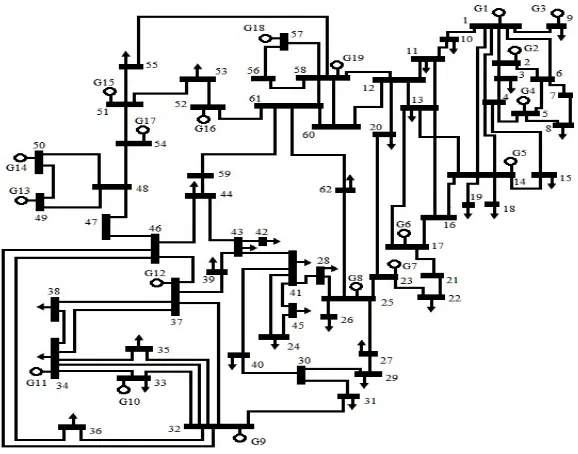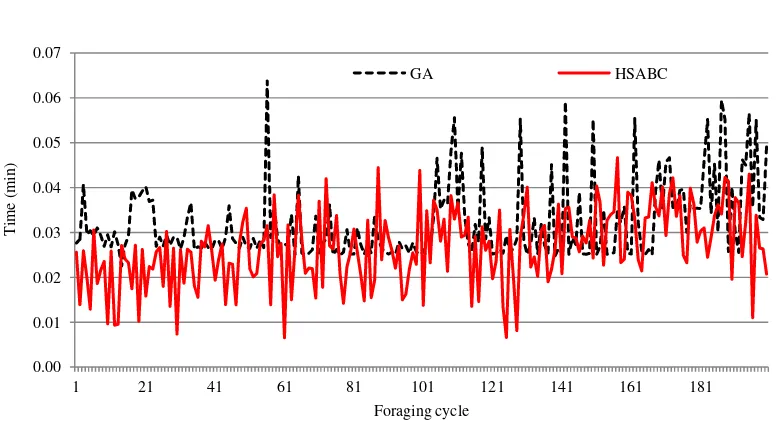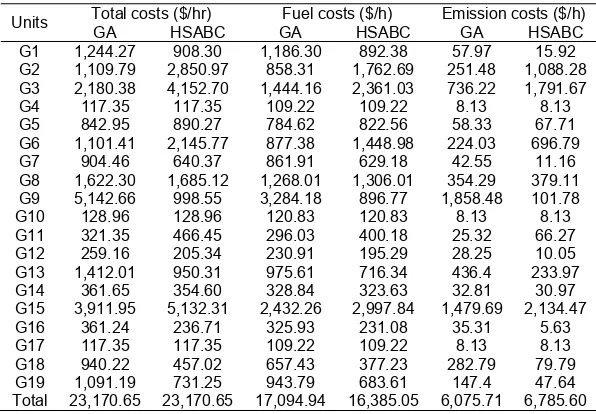DOI: 10.12928/TELKOMNIKA.v13i4.3166 1187
Comparing Performances of Evolutionary Algorithms
on the Emission Dispatch and Economic Dispatch
Problem
AN Afandi1, Irham Fadlika2, Andoko3
1,2Electrical Engineering, Universitas Negeri Malang, Jl. Semarang 5, Building G4, Malang, Jawa Timur, Indonesia
3Faculty Member of Engineering, Universitas Negeri Malang, Jl. Semarang 5, Building H5, Malang, Jawa Timur, Indonesia
e-mail: [email protected], [email protected], [email protected], [email protected]
Abstract
Evolutionary methods dominate in the computation for breaking out the real problems. For a couple of years, it is more popular than classical methods for solving many cases. Technically, one of real problems is the emission dispatch and economic dispatch (EDED) problem. The EDED problem is used to optimize the power system operation (PSO) at a certain time under some constraints. This paper presents performance comparison between Harvest Season Artificial Bee Colony (HSABC) and Genetic Algorithms on the EDED problem applied to the IEEE-62 bus system. Simulation results show that the tested methods have difference characteristics and abilities for optimizing the PSO based on the EDED problem.
Keywords: economic dispatch, emission dispatch, genetic algorithm, HSABC algorithm, power system
operation
Copyright © 2015 Universitas Ahmad Dahlan. All rights reserved.
1. Introduction
At present years, many important decisions are made from describing the optimal solution for measuring the real problem of the real operation based on desirable solutions to meet operational constraints while existing in the certain condition. In particular, many mathematical and optimization techniques have been proposed to solve the problems and several previous works have been successfully applied to carry out real problems [1], [2], [3]. Other studies have also reported many techniques for obtaining the optimal solution categorized into classical methods and evolutionary methods [4], [5], [6], [7], [8], [9]. In general, evolutionary methods are consisted of many algorithms based on natural entity behaviors which are adopted as optimization methods for improving performances of classical techniques. Moreover, evolutionary methods dominate in computations for determining solutions of optimization problems on many applications with various themes. These methods are commonly developed as an intelligent computation for searching the optimal solution using an optimization technique in multiple constraints.
For a couple of years, genetic algorithm (GA) is more popular than other algorithm in the implementation of evolutionary methods in many variants as presented in many previous studies. In principles, this algorithm has been inspired by a phenomenon of a natural evolution and many previous works have used to carry out optimization problems applied to solve many topics. Its procedures for selecting the optimal solution are performed by several steps covered population, natural selection, crossover, and mutation. In detail, principles and procedures of GA are discussed clearly in literatures [3], [10], [11], [12]. Recently, the latest variant of evolutionary methods is harvest season artificial bee colony (HSABC) algorithm promoted in 2013. This algorithm is composed using bee behaviours and the harvest season situation, and its function is discussed clearly as the computing ability in [13].
technical constraints and conditional limits. In these studies, this problem is used for comparing GA and HSABC on both performances throughout the computing ability while searching the optimal solution under various constraints and limitations.
2. Genetic and Harvest Season Artificial Bee Colony Algorithms
As mentioned before, intelligent computations are consisted of evolutionary methods composed using a population based algorithm. Many methods have been introduced to attempt the natural phenomenon for creating various evolutionary algorithms and it has been successful applied to the optimization problems[2], [3], [4], [8], [10], [14], [15]. Specifically, for the last ten years, the most popular of evolutionary algorithms is GA inspired by a phenomenon of the natural evolution. GA’s procedures for selecting the optimal solution are performed by several steps, such as, population; natural selection; crossover; and mutation, as discussed clearly in [3], [10], [15]. Many previous works have used GA for solving optimization problems of the PSO and this algorithm has been applied to solve various topics of dispatching powers for determining the optimal solution and for scheduling power outputs of generating units. In detail, principles and procedures of GA are clearly discussed in literatures [3], [10], [16], [15]. These studies are conducted to those previous works for GA’s principles and hierarchies.
In particular, HSABC algorithm was proposed on March 2013 after developing and introducing early its structures in 2012 based on the harvest season situation consisted of blooming flowers in its area and bee’s behaviors while searching for foods. In detail, flowers are expressed using multiple food sources related to the first food source and the other food sources. Each food source is located randomly at a certain position using a harvest operator [13], [17]. In principle, the sequencing computation of HSABC algorithm is distributed into several processes to select the optimal solution as following orders as adopted in these studies [5], [14]:
Generating population: create initial population sets, evaluate initial population sets, and define the population.
Food source exploration: produce the first food source, produce the other food sources, evaluate the multiple food sources, apply the greedy process, and calculate the probability value.
Food selection: produce a new food, produce neighbor foods, evaluate foods, and apply the greedy process.
Abandoned replacement: determine an abandoned food, replace with a new randomly one, and memorize the food.
3. Emission Dispatch and Economic Dispatch
In general, the PSO is structured using various parts and equipments for establishing an integrated system to deliver electric energy from generating webs to usage areas under certain operational constraints with the distributed own power consumption. Technically, this operation should be provided in reasonable budgets for all processes in 24 hours of the operating period forced in environmental requirements [14]. Recently, the environment protection is considered in the PSO to reduce pollutant productions at thermal power plants discharged in various particles and gasses, like CO, CO2, SOx and NOx [2], [3], [12], [14], [15], [18]. To cover these problems, the PSO considers financial and environmental aspects for searching the balance decision between emission dispatch and economic dispatch with its different orientation troughout the EDED formulation as single objective function for determining the optimal solution and plotting a committed schedule of generating unit outputs.
Basically, the EDED is addressed to minimize the total fuel cost included the pollutant reduction with considering several limitations for the PSO. Moreover, the EDED problem is composed using penalty and compromised factors for combing financial and environmental aspects. The penalty factor is used to shows the coefficient rate of each generating. The compromised factor shows the contribution of pollutants and costs in the computation. In addition, economic dispatch; emission dispatch; and the EDED problem are formed in expression (1); (2); and (3).
Emission dispatch: E ∑ . P α. P , (2)
EDED problem: w. F 1 w . h. E, (3)
where Pi is a output power of ith generating unit (MW), ai; bi; ci are fuel cost coefficients of ith generating unit, Ftc is a total fuel cost ($/h), ng is number of generating unit, αi; i; i are emission coefficients of ith generating unit, Et is a total emission (kg/h), is the EDED ($/h), w is a compromised factor, and h is a penalty factor.
4. Tested System and Procedures
To compare performances of GA and HSABC, designed programs of both algorithms are applied to a standard model from Institution of Electrical and Electronics Engineers (IEEE). IEEE’s models are often adopted as sample systems for simulating many problems. These standard models are also useful and effective to test related problems of the PSO because of available provided technical data. In particular, many problems of the PSO are approached using these standard models in order to know characteristic; performances; and results of the problems. In these studies, the IEEE-62 bus system is selected as a tested system for both algorithms.
Table 1. Fuel Cost and Emission Coefficients of Generators
Bus Gen a, x10
In these studies, the IEEE-62 bus system is adopted as a sample model of the PSO for comparing ability of GA and HSABC. In detail, this system is developed using 19 generators, 62 buses and 89 lines. One line diagram of the IEEE-62 bus system is shown in Figure 2. Its generating coefficients are listed in Table 1 for fuel consumptions and pollutant productions of 19 units.
Figure 1. Sequencing procedures for the comparison
Figure 2. One-line diagram of IEEE-62 bus system
In these simulations, operational constraints are also used to put desired solutions in the feasible ranges of the PSO. In detail, operational constraints are defined in 5% of maximum and minimum limits of fluctuated voltages; 90% of the maximum power transfer capability on transmission lines; an equality of total powers between generating units, power losses, and loads; maximum and minimum power limits of generating units; 15% of the maximum total power loss; and the emission standard.
5. Results and Discussion
These works are addressed to obtain the optimal solution of the PSO through the EDED solved using HSABC and GA. These simulations are also used to compare its ability based on the EDED. To demonstrate GA and HSABC, these simulations have considered 2,912 MW of the power demand; 0.5 of the compromised factor; 0.85 kg/MWh of the emission standard; the dominant penalty factor. For executing designed programs of HSABC, this algorithm has been applied to solve the EDED using the colony size= 50; food sources= 25; and 200 of foraging
Technical parameters
Environmental requirements
EDED
problem HSABC
GA
Results
Numerical comparison
cycles. Each process of GA has considered its procedures and hierarchies as discussed clearly in several references [2], [10], [11]. In these simulations, GA has been also implemented using its qualified parameters covered population; natural selection; crossover; mutation; and others. In detail, main parameters of GA have used population= 50; natural selection= roulette; crossover= scattered; mutation= Gaussian; and maximum generation= 200.
In particular, numerical results are provided in Table 2. Performances of the EDED are also presented graphically in Figure 3 and Figure 4. These figures illustrate performances in terms of convergence speeds and time consumptions. Figure 3 shows convergence speeds of used intelligent computations for two types of evolutionary algorithms associated with each selection for obtaining the optimal solution from available candidate solutions in the population. This figure illustrates progressing optimal solutions of the EDED problem computed using GA and HSABC for 200 cycles. By considering all parameters and operational constraints for solving the problem, optimal solutions of the EDED have been initialed at different points before leveling at the optimal solution as shown in Figure 3 with the fastest is HSABC. In addition, the execution of designed programs for each algorithm has consumed a certain time to complete all computations while obtaining the optimal solution of the EDED with different characteristics as given in Figure 4. In total, both time consumptions are listed in Table 2 with the shortest is HSABC. According to this table, the optimal solution of the EDED is settled at 11,585.13 $/h with different budgeting fees for pollutants and fuels.
Figure 3. Convergence speeds of EDED’s computations
Figure 4. Time consumptions of EDED’s computations
11,450 11,500 11,550 11,600 11,650 11,700 11,750 11,800
1 21 41 61 81 101 121 141 161 181
EDED ($
/h
)
Foraging cycle
GA HSABC
0.00 0.01 0.02 0.03 0.04 0.05 0.06 0.07
1 21 41 61 81 101 121 141 161 181
Tim
e (m
in
)
Foraging cycle
Table 2. Computing Performances
Subjects GA HSABC Subjects GA HSABC
Fuels ($/h) 8,547.47 8,192.53 Range ($/h) 176.66 72.41
Pollutants ($/h) 3,037.66 3,392.60 Optimal cycle 104 11
EDED ($/h) 11,585.13 11,585.13 Optimal time (min) 3.04 0.21
Start point ($/h) 11,761.85 11,657.60 Total time (min) 6.40 5.32
Table 3. Power and Pollutant Performances
Units Powers (MW) Pollutant (kg/h)
GA HSABC GA HSABC
G1 140.24 105.75 124.48 34.18
G2 168.18 305.14 540 2,336.86
G3 258.16 380.22 1,580.89 3,847.27
G4 91.89 91.89 17.45 17.45
Total 3,302.25 3,204.88 13,045.71 14,570.74
Table 4. Cost Performances
Units Total costs ($/hr) Fuel costs ($/h) Emission costs ($/h)
GA HSABC GA HSABC GA HSABC
G1 1,244.27 908.30 1,186.30 892.38 57.97 15.92 G2 1,109.79 2,850.97 858.31 1,762.69 251.48 1,088.28 G3 2,180.38 4,152.70 1,444.16 2,361.03 736.22 1,791.67 G4 117.35 117.35 109.22 109.22 8.13 8.13 G5 842.95 890.27 784.62 822.56 58.33 67.71 G6 1,101.41 2,145.77 877.38 1,448.98 224.03 696.79 G7 904.46 640.37 861.91 629.18 42.55 11.16 G8 1,622.30 1,685.12 1,268.01 1,306.01 354.29 379.11
G9 5,142.66 998.55 3,284.18 896.77 1,858.48 101.78
G10 128.96 128.96 120.83 120.83 8.13 8.13
G11 321.35 466.45 296.03 400.18 25.32 66.27
G12 259.16 205.34 230.91 195.29 28.25 10.05
G13 1,412.01 950.31 975.61 716.34 436.4 233.97
G14 361.65 354.60 328.84 323.63 32.81 30.97
G15 3,911.95 5,132.31 2,432.26 2,997.84 1,479.69 2,134.47
G16 361.24 236.71 325.93 231.08 35.31 5.63
G17 117.35 117.35 109.22 109.22 8.13 8.13
G18 940.22 457.02 657.43 377.23 282.79 79.79
G19 1,091.19 731.25 943.79 683.61 147.4 47.64
Total 23,170.65 23,170.65 17,094.94 16,385.05 6,075.71 6,785.60
payments have been considered in the PSO. According to these tables, it is indicated that generating units use various payments for producing power outputs. Regarding in combinations of power outputs, generating units have been operated using different budgets. Focused on the total operating cost, it has been optimized economically in 23,170.65 $/h determined by both computations, although it has spent different total costs of fuel consumptions and pollutant compensations.
6. Conclusion
This paper compares GA and HSABC while solving the EDED using IEEE-62 bus as a sample system. Obtained results show that both algorithms have different characteristics and performances for the EDED problem. Its convergence speeds are smooth and quick to select optimal solutions. Focused on the solution quality and the computational efficiency, HSABC has searched for the optimal solution in the fastest speed and the shortest time. Numerically, both algorithms have produced similar results.
References
[1] Mian Xing, Ling ji, Baiting Xu. Multiple Objective Optimizations for Energy Management System under Uncertainties. Telkomnika. 2013; 11(12): 7044-7051.
[2] Yunzhi Cheng, Weiping Xiao, Wei-Jen Lee and Ming Yang (2009). A New Approach for Missions and
Security Constrained Economic Dispatch. NAPS, IEEE Conference Publication. Starkville. 2009: 1-5.
[3] R Gopalakrishnan, A Krishnan. A Novel Combined Economic and Emission Dispatch Problem Solving Technique using Non-dominated Ranked Genetic Algorithm. European Journal of Scientific
Research. 2011; 64(1): 141-151.
[4] K Sathish Kumar, V Tamilselvan, N Murali, R Rajaram, N Shanmuga Sundaram and T Jayabarathi. Economic Load Dispatch with Emission Constraints using Various PSO Algorithm. WSEAS
Transaction on Power System. 2008; 9(3): 598-607.
[5] AN Afandi. Optimal Solution of the EPED Problem Considering Space Areas of HSABC on the Power System Operation. International Journal of Engineering and Technology. 2015; 7(5): 1824-1830. [6] AA El-Keib, H Ma, and JL Hart. Environmentally Constrained ED using the Lagrangian Relaxation
Method. IEEE Trans. Power Systems.1994; 9(4): 1723-1729.
[7] Ahmed Farag, Samir Al-Baiyat, TC Cheng. Economic Load Dispatch Multiobjective Optimization Procedures using Linear Programming Techniques. IEEE Transactions on Power Systems. 1995; 10(2): 731-738.
[8] ZL Gaing. Particle swarm optimization to solving the ED considering the generator constraints. IEEE
Trans. Power Systems. 2003; 18(3): 1187-1195.
[9] K Chandram, N Subrahmanyam, M Sydulu. Secant Method for Economic Dispatch with Generator Constraints and Transmission Losses. Journal of Electrical Engineering and Technology. 2008; 3(1): 52-59.
[10] H Chahkandi Nejad, R Jahani, M Mohammad Abadi. GAPSO-Based Economic Load Dispatch of Power System. Australian Journal of Basic and Applied Sciences. 2011; 5(7): 606-611.
[11] Xuesong Yan, Wei Li, Wei Chen, Wenjing Luo, Can Zhang, Qinghua Wu. Weighted K-Nearest Neighbor Classification Algorithm Based on Genetic Algorithm. Telkomnika. 2013; 11(10): 6173-6178.
[12] Mukesh Garg, Surender Kumar. A Survey on Environmental Economic Load Dispatch using Lagrange Multiplier Method. International Journal of Electronics & Communication Technology. 2012; 3(1): 43-46.
[13] Arif N Afandi, Hajime Miyauchi. Improved Artificial Bee Colony Algorithm Considering Harvest Season for Computing Economic Dispatch on Power System. Transaction on Electrical and
Electronic Engineering. 2014; 9(3): 251-257.
[14] AN Afandi. Optimal Scheduling Power Generations using HSABC Algorithm Considered a New
Penalty Factor Approach. IEEE Conference on Power Engineering and Renewable Energy. Bali.
2014; 13-18.
[15] Ioannis G Damausis, Anastasios G Bakirtzis, Petros S Dokopoulos. Network Constrained Economic Dispatch using Real Coded Genetic Algorithm. IEEE Trans. Power Systems. 2003; 18(1): 198-205. [16] Sun Hongbin, Tian Chunguang. Optimizing Multi-agen MicroGrid Resource Scheduling by
Co-Evolutionary with Preference. Telkomnika. 2012; 11(12): 7222-7229.
[17] AN Afandi, Hajime Miyauchi. Solving Combined Economic and Emission Dispatch Using Harvest Season Artificial Bee Colony Algorithm Considering Food Source Placements and Modified Rates.
International Journal on Electrical Engineering and Informatics, 2014; 6(2); 266-279.



